Astrantia: description and varieties, planting and care
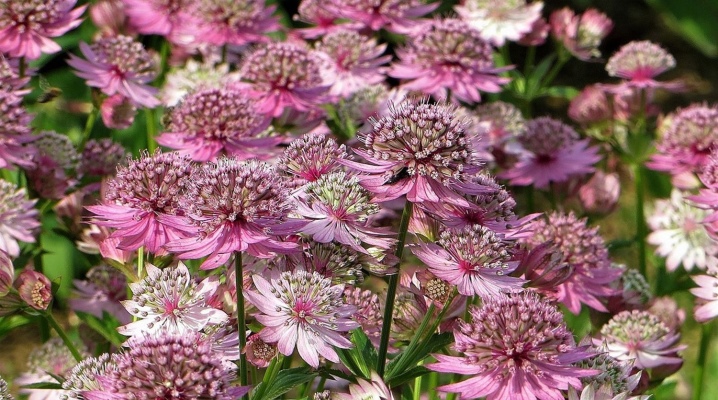
Currently, a huge number of varieties of flowering plants are known, so it can be quite difficult to choose one of them. Experts recommend not to ignore Astrantia, since it not only has high decorative characteristics, but is also considered an excellent honey plant, and is also quite easy to grow.
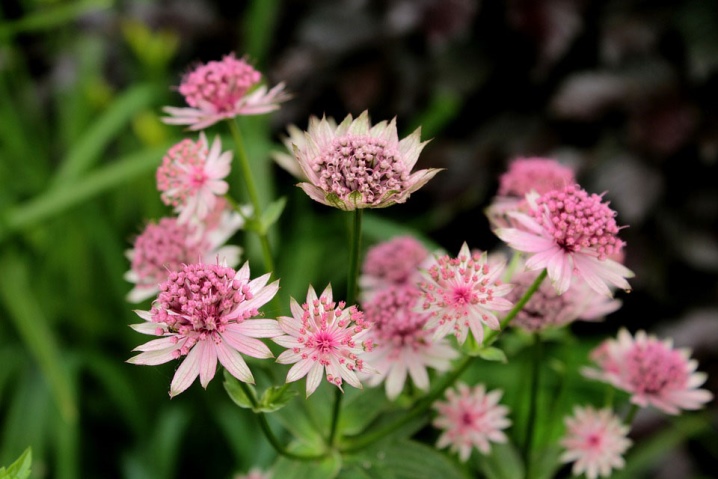
Peculiarities
Astrantia, or zvezdovka, is a member of the umbrella family. This herbaceous representative of the flora can be found in different parts of Europe. And also the culture is widespread in the Caucasus. In American cities, people have been cultivating it since the 16th century. Nowadays, breeder scientists have bred a large number of varieties of this plant, which often live in personal plots.
The description of the star indicates that it is characterized by straight, slightly leafy, slightly branched shoots... In height, this representative of the flora reaches from 15 to 100 centimeters. The leaf plate of the plant is characterized by a finger-like structure. The foliage is collected in a root rosette. The inflorescence is simple, umbrella-shaped, very similar to a star.
In the inflorescence there are many flowers of ruby-pink, white and other shades. The decorativeness of the culture is given by wrapper leaves with a rich green color.
The blooming phase of Astrantia begins in May and ends in early autumn. The fruit of a herbaceous plant is presented in the form of a two-seed.
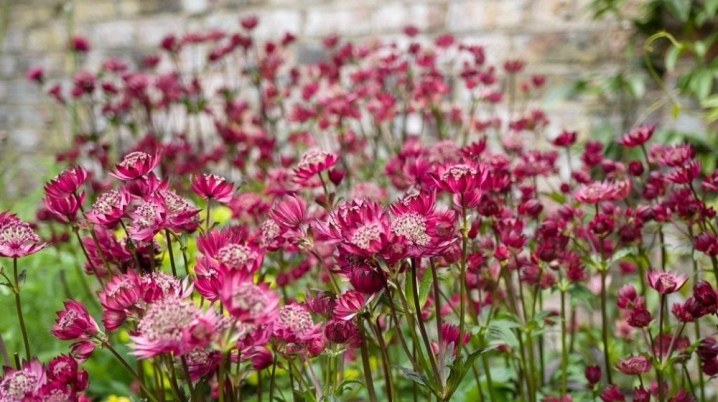
The culture is considered an excellent honey plant, so a large number of bees flock to it.
This representative of the flora is undemanding and able to take root in almost any area due to its ability to withstand negative environmental factors.
However, Astrantia is not the only star. There is also Hacquetia epipactis (asterisk epipactis) - a rhizome perennial, the only species in the genus. According to the botanical description, Epipactis does not belong to Astrantia, but is its relative, since it also belongs to the umbrella family. And also in the spring, yellow inflorescences appear on its bushes, vaguely resembling Astrantia flowers.
Therefore, do not confuse them. And we will further call Astrantia a star.
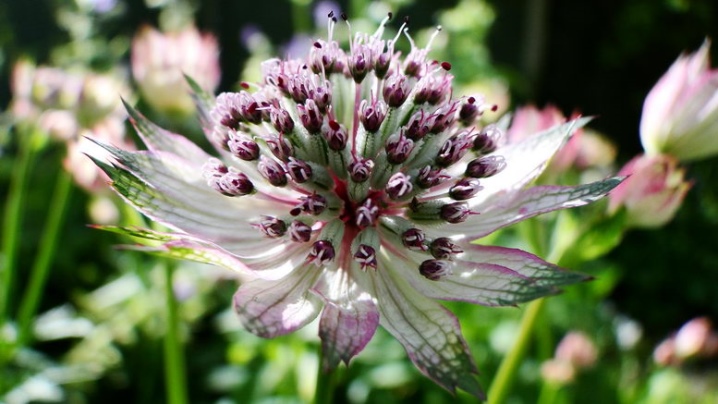
Types and varieties
Perennial Astrantia has about 10 varieties with unusual names, of which several of the most popular are most often used to decorate the territory.
- Small. Varieties of this species usually reach a height of 80 cm. Their main difference is considered to be small openwork foliage, as well as small flowers with a diameter of about 3 centimeters. Herbaceous perennials bloom from July to August.
- Large. The foliage that is located on a long stalk, together, forms a lush curtain. The varieties of this representative of the flora do not exceed 70 centimeters in height. The blossoming buds reach 5 centimeters in diameter. The flowering phase of a crop lasts about 5 weeks.
- The greatest. The average height of the culture is considered to be 70 cm. Despite its short stature, this plant is characterized by the presence of lush clumps, which are formed by thick leaves and decorative bracts. Umbrella inflorescences are dense hemispheres. Astrantia of this species blooms from late summer to late autumn.
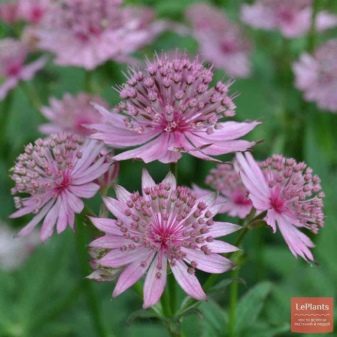
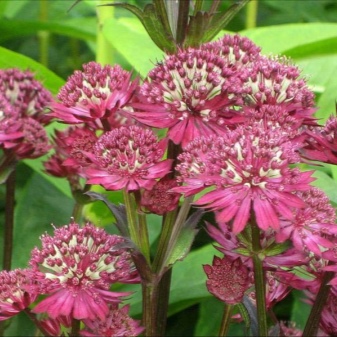
Consider the most common varieties of Astrantia.
- "Moulin rouge" is a herbaceous perennial with a straight, slightly leafy stem. The beautiful foliage of the culture is collected in a root rosette. The flower looks quite impressive due to its red-wine or purple color with a greenish core. The height of the culture does not exceed 90 centimeters. The flowering phase in Astrantia lasts the entire season.
Moulin Rouge is an unpretentious and frost-resistant flora. Zvezdovka of this variety loves sunny areas for growth.
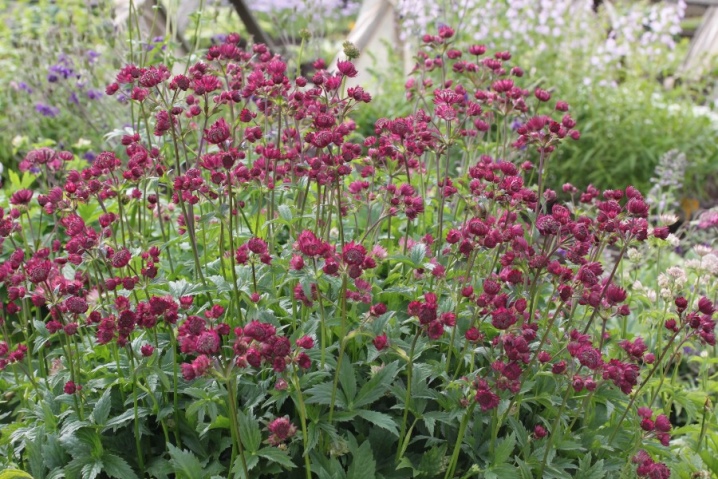
- "Pink Symphony" - this unpretentious plant is characterized by an abundance of flowering. In the phase of bud formation, the plant reaches a height of 70 cm and a width of 40 cm. Basal leaves in an amount of 3 to 7 pieces are located on long petioles. Monochromatic pink-red flowers are collected in umbellate inflorescences. The cultivation of the "Pink Symphony" can be both single and group.
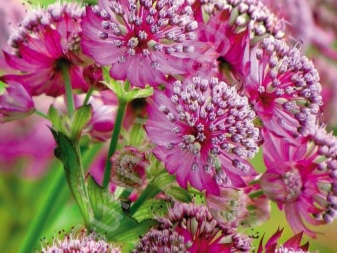
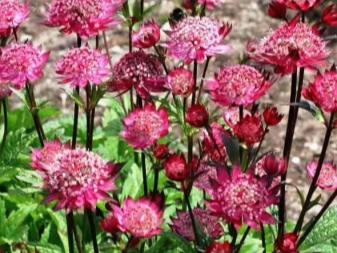
- Roma. This variety is considered a perennial, it grows no more than 70 centimeters in height. The leaves of the culture are finger-dissected, located on long petioles. There are many flowers in Astrantia, they are small, pink in color. The bract is usually large, pale pink in color. The flowering phase occurs in June - September.

- Rubra. Perennial rhizome herbaceous culture is characterized by a straight stem with small foliage. Large foliage is in the root rosette. The flowers are small, there are many of them. The leaf wrapper is large, it gives the plant a decorative effect.
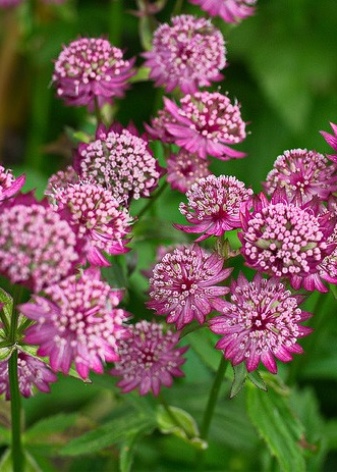
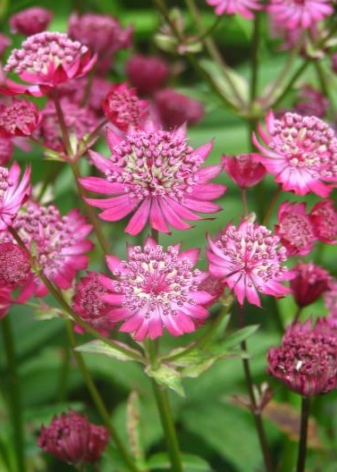
- Ruby Wedding. Large Astrantia has an inflorescence in the form of a complex umbrella. The bracts of the plant are characterized by a beautiful shade, the flowers are small, dark cherry in color. The foliage is dark green ornamental.
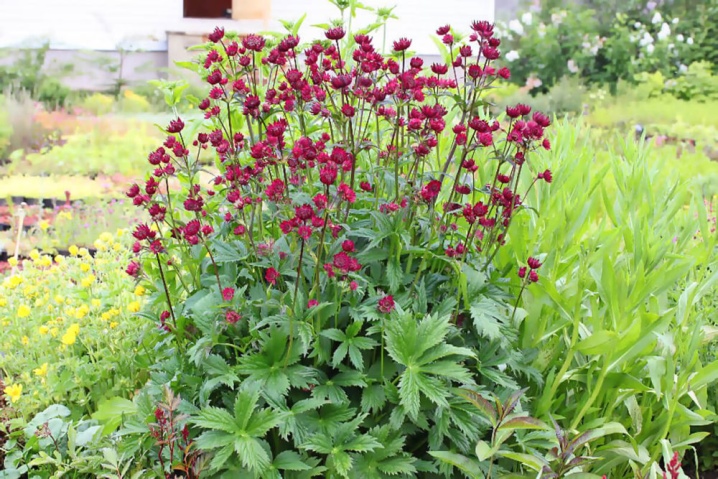
- "Rosea" belongs to the largest type of Astrantia. This perennial herb often grows up to 90 centimeters. The flowering phase occurs in the second half of summer, in some cases, re-flowering may occur. The inflorescence of the culture has a bright pink color, the leaf plates are characterized by the original spotting.
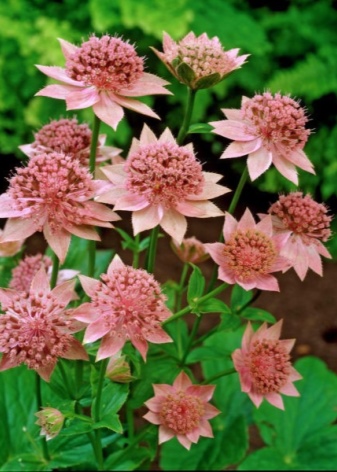
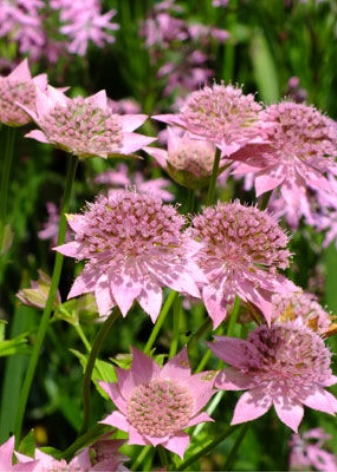
- "Venice". This variety of Astrantia can grow up to 60-70 centimeters in height. The culture blooms throughout the season, characterized by the presence of bright crimson flowers.
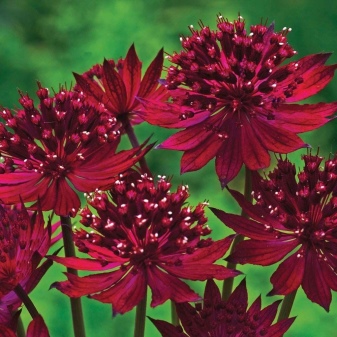
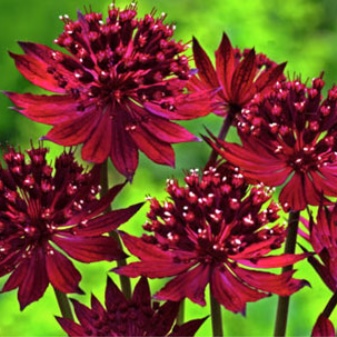
- "Claret" - this beautiful culture is characterized by the presence of wine-red or burgundy inflorescences and transparent wrappers of an identical shade. The height of this honey plant does not exceed 55 centimeters. Perennial blooms from early summer to late September. The flowering phase of the plant is long.
Claret looks great with a large group of trees.
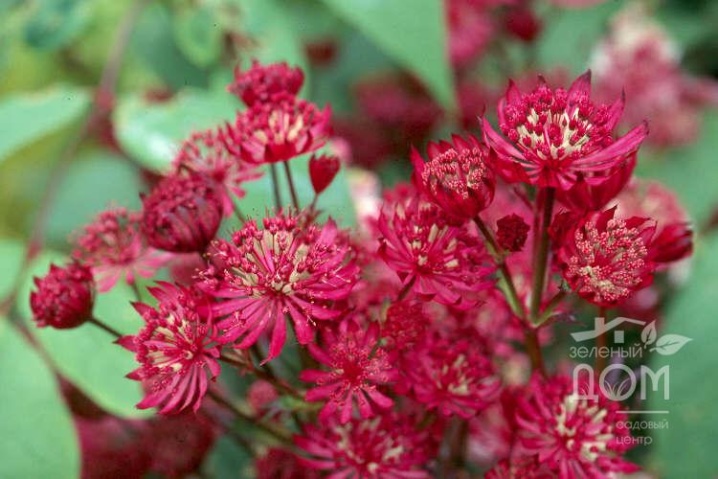
- "Prima Donna" - perennial, has bright green leaves. In adulthood, the culture reaches a height of 60 to 70 centimeters. Thanks to the beautiful shiny foliage, the Astrantia of this variety looks like a compact decorative bush. Small flowers are colored red or purple.
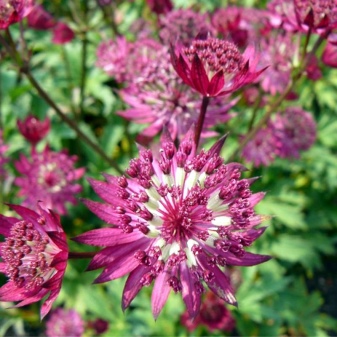
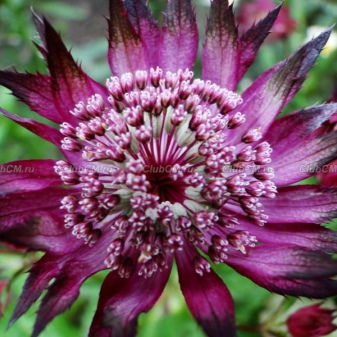
- "Shaggy" - this garden dweller can grow up to 80 centimeters. The flowers of the plant are white with greenish patterns. Starfish blooms from June to August. Carved foliage and delicate flowers of Astrania make it an ornamental garden representative of flora, which goes well with other plants.
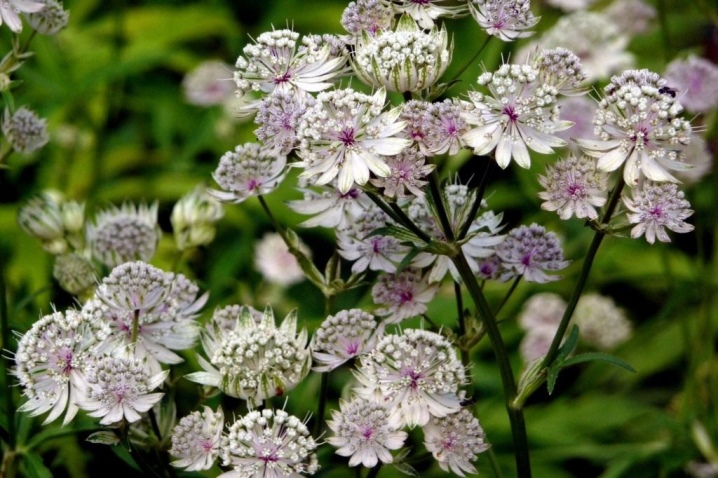
- "Venice" Is an attractive perennial with deep purple flowers. The spreading bushes are about 40 centimeters in diameter. This drought-resistant, cold-resistant flora can grow both alone and in groups.
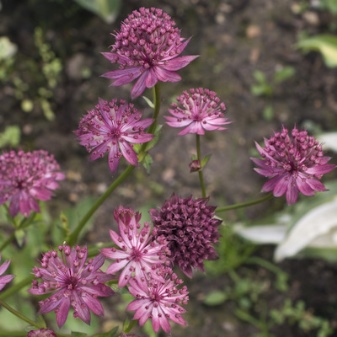
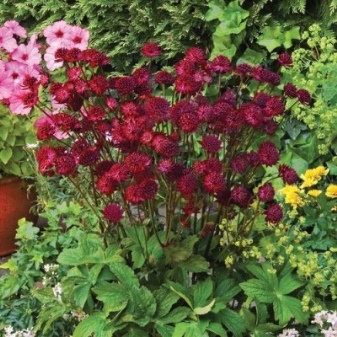
- Star of Love. This type of star is considered a worthy option for an original bouquet. The plant has high decorative qualities due to its beautiful purple flowers.
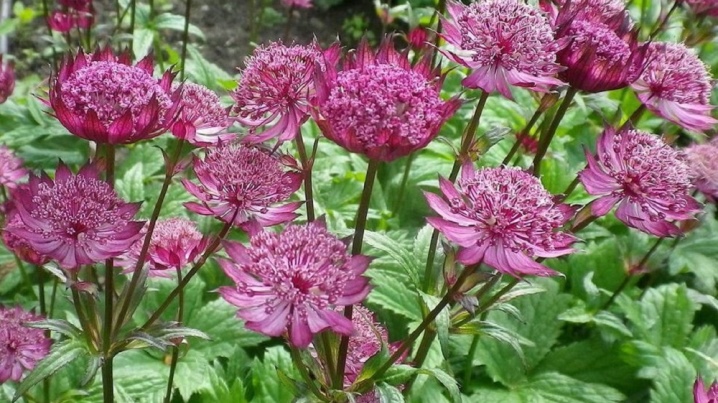
- Alba. The height of this perennial herb ranges from 70 to 90 centimeters. The width of the plant does not exceed 45 cm. The weakly branched bush has straight stems. The foliage of the starlet is characterized by a palm-like shape, it is long and located in the root rosette.White flowers are collected in inflorescences in the form of umbrellas.
A distinctive feature of this variety of Astrantia is the presence of large bracts.
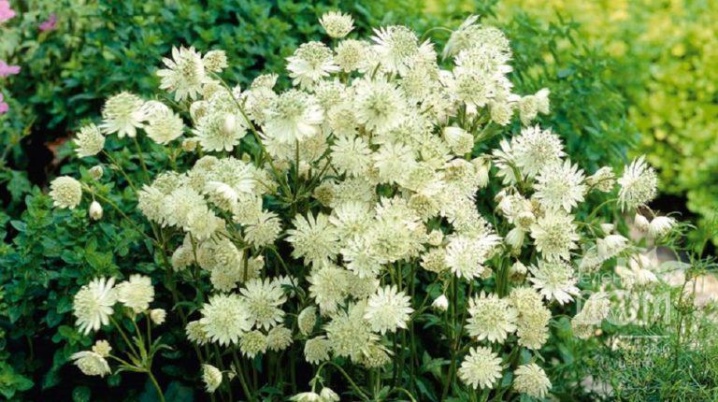
- "Red Joyce" is a strong plant with large, beautiful buds. The flowers have a bright wine color. The height of the culture is 70 cm, and its width is 40 cm. The culture blooms from June to early autumn. It is worth growing Astrantia of this variety outdoors.
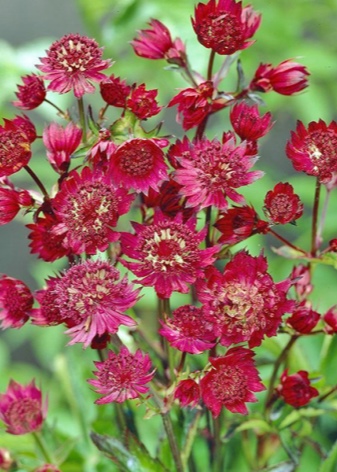
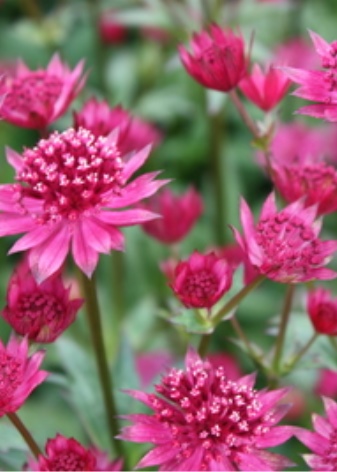
- "Florence" - a perennial culture, up to 80 cm high. This variety is considered one of the best due to the presence of original pink flowers. Beautiful dissected leaves acquire a purple hue over time. A powerful shrub characterized by bright, abundant flowering.
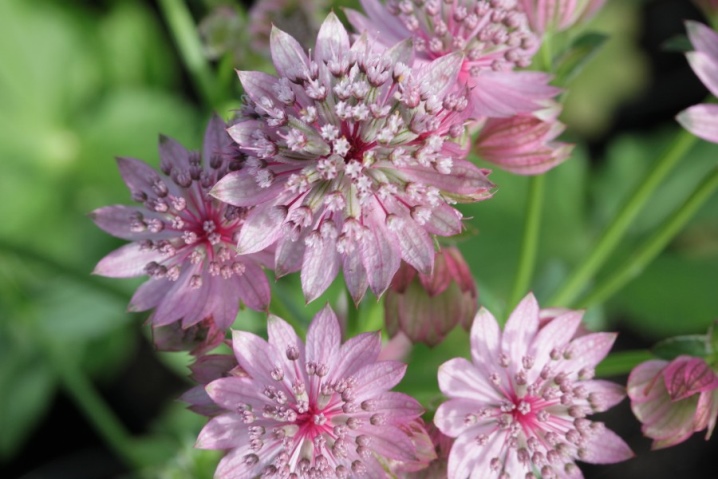
- Snow is old. A decorative representative of the flora is often used for planting on a lawn, mixborder, in compositions with stones. Great for cutting. The height of the culture can reach 60 centimeters.
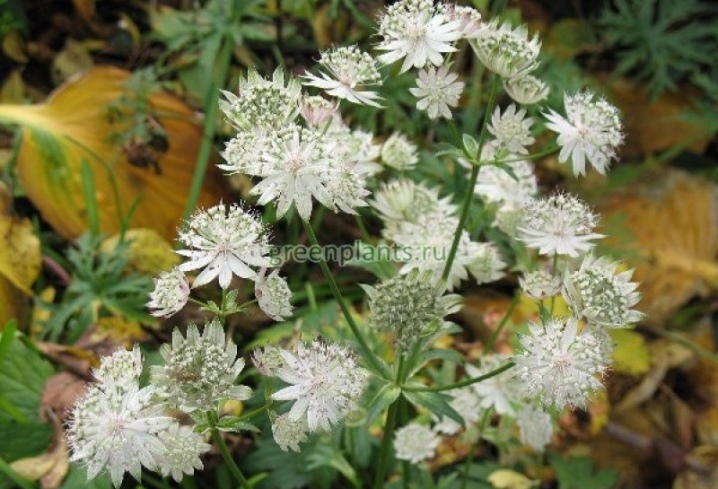
- "Lars". Astrantia is characterized by spectacular large pink flowers that gather in umbrella inflorescences. The culture has bright dark pink bracts. The blooming period of the starfish is from June to September. The plant has found its use in drying and cutting.
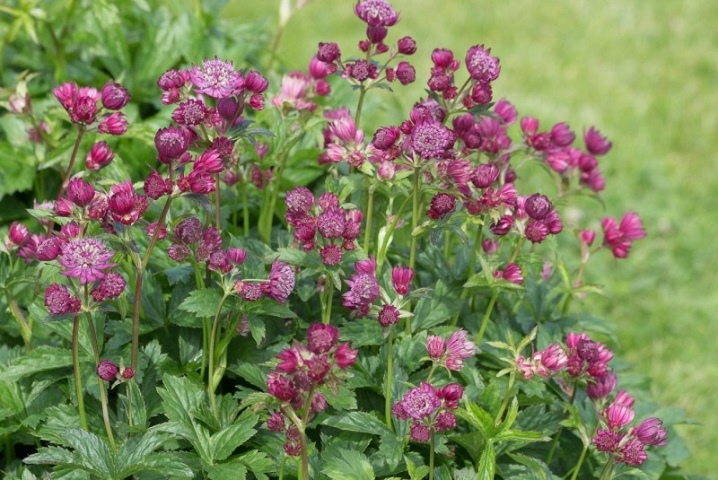
- Billion Stars. Perennial plant with small white flowers. The culture can be planted not only in groups, but also individually.
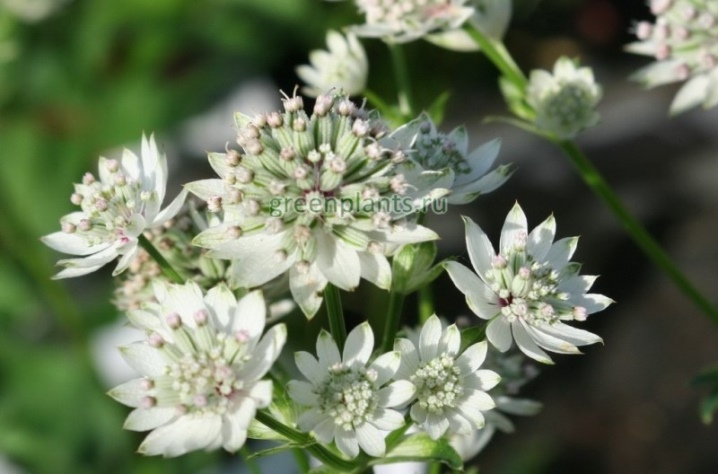
- Star of Fire - this is Astrantia with large burgundy buds. The culture has a dark purple stem, as well as a white flower core. The perennial blooms profusely and for a long time. Star of Fire is considered ideal for cutting and creating bouquets.
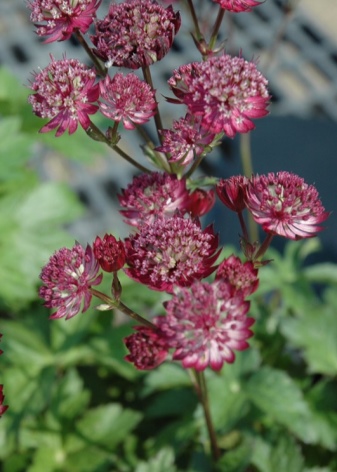
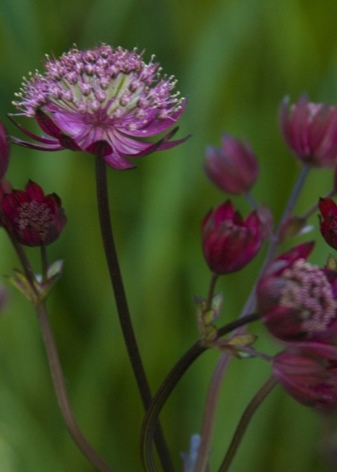
- Sunningdale Variegated It stands out among other plants not only for its beautiful pink flowers, but also for its decorative foliage. This representative of the flora blooms from July to August. An adult plant can reach a height of no more than 70 cm.


Growing seedlings
Astrantia belongs to unpretentious and frost-resistant crops, so it can be planted in open ground. However, for successful breeding of this culture at home, it is better to start growing seedlings. The purchase of starfish seeds can be done in a specialized store or assemble with your own hands. One of the main conditions for good germination is the stratification of seed material. To this end, it must be mixed with moistened sawdust, sand and sent to the refrigerator on the lower shelf for a period of at least a month.
Soil and capacity
The seedling soil should be light and nutritious. Seeds are sown shallow and dive early enough, so the container for planting should be selected shallow, otherwise the soil will begin to sour.
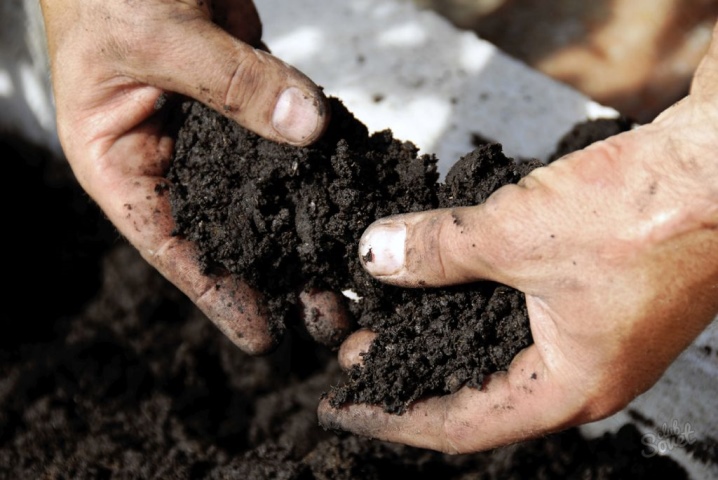
Sowing seeds
As already mentioned, the main rule when sowing seed material of Astrantia is that it should be done shallowly. After the procedure, the substrate must be slightly compacted. After the seedlings have sprung up and become strong, they should be thinned out. For irrigation, it is better to use a spray bottle with warm water. The container with plantings should be kept in a warm and bright room.

Seedling care
Seedlings will only grow healthy with proper care. Despite the fact that the adult Astrantia grows well in the shade, the presence of sunlight is very important for seedlings. With insufficient lighting, the young culture will be elongated, pale, with underdeveloped foliage. For this reason winter seedlings require additional lighting with lamps. But in the spring, natural light will be enough for the seedlings.
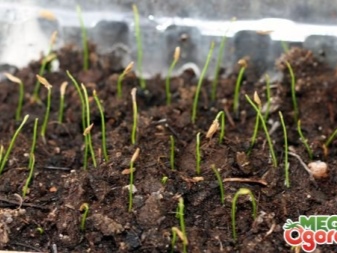
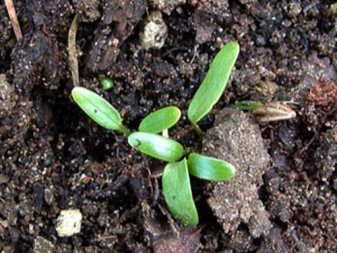
A seedling culture is quite sensitive to temperature extremes.
The optimal indicator for it is 22 degrees of heat. When airing the room, you should not allow drafts. It is worth watering the plantings every 2-3 days as the soil dries out. The main thing is not to overmoisten the soil, as this can cause rotting of unformed roots. Fertilizing the plant is not required at this stage.
You can start picking young stars when they have a couple of real leaves. Seedlings are planted very carefully to avoid damage to the root system. Plants are planted in separate small containers with light soil. At the end of the dive, the soil should be slightly compacted. When young Astranians take root in a new place, you can start hardening them.
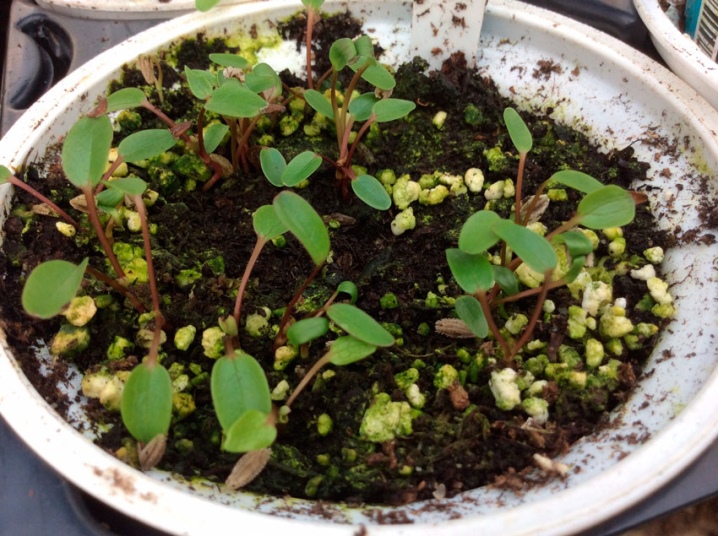
Landing in open ground
After the seedlings get stronger, they begin to be planted in open ground. The planting procedure in the Moscow region and other regions of the country does not imply complex activities, however, it requires some knowledge of the culture from the gardener.
Optimal timing
According to the rules, the best time to plant a starfish on a permanent territory is the end of May or the beginning of June. The culture belongs to frost-resistant, but it is better to choose a time when the air temperature does not drop below 10 degrees at night.
Seat selection
A gardener should choose the right site on which astrantia will grow in the future. In this case, it is better to give preference to a place with good illumination or in a small shade of trees. The territory should have a nutritious and loose substrate, the composition of which does not matter in this case.
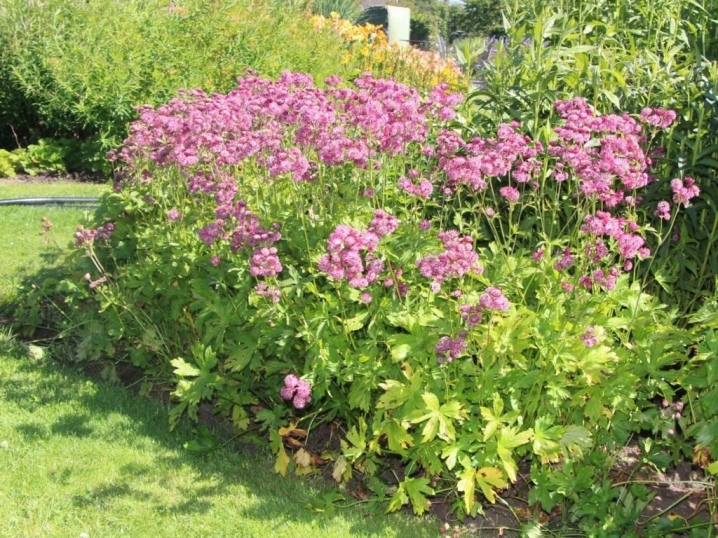
Fundamental rules
When planting a star in open ground, you should follow these simple rules:
- keep a distance between plants of 30-40 centimeters;
- the level of the planted culture should be the same as it was in the container;
- around the seedlings, it is worth carefully tamping the soil, and then watering it.
A herbaceous perennial will be able to bloom 3 years after planting.

How to take care of it properly?
Caring for this representative of the flora, the gardener does not have to spend a lot of time and effort - even a novice florist can handle an unpretentious specimen.
Watering
If the summer turned out to be non-arid, with a normal amount of precipitation, then there is no need to water the starlet. Astrantia can survive a short drought. In the case of a long absence of rain, it is worth watering the crop once every 7 days. If you want to achieve repeated flowering of the culture in one season, it is worth making sure that the soil is always moist.
Mulching with peat or humus is an opportunity to maintain the required level of moisture, as well as prevent the spread of weeds.
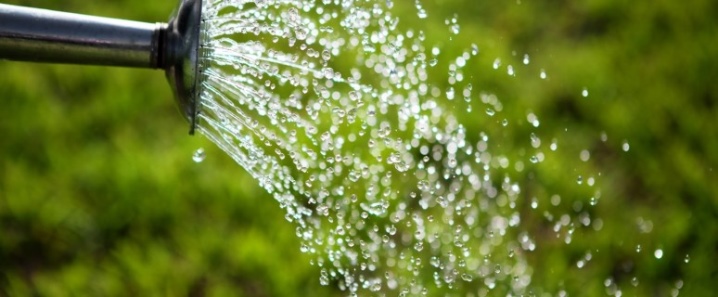
Top dressing
A sprocket that has recently been planted in fertile soil will not need fertilization. A perennial growing for the second year already needs complex feeding in the spring. If the soil is poor, and the culture is more than 3 years old, then in the middle of summer, Astrania should be fed with a substance based on phosphorus or potassium.
Ready-made liquid fertilizers are considered the best option for this representative of the flora.
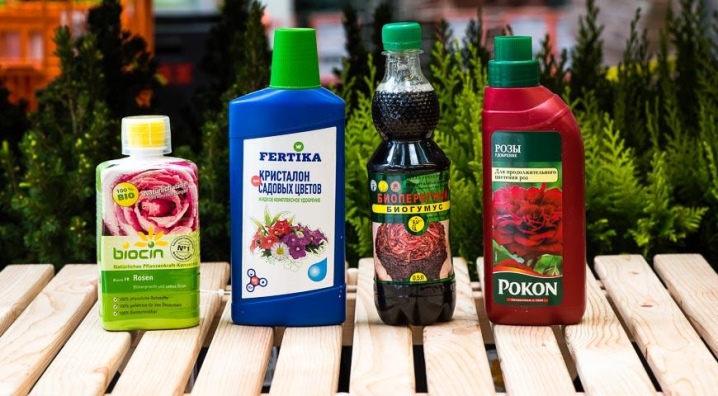
Weeding and loosening
The gardener should remember that after watering or rain, it is worthwhile to loosen the soil near the star. Thanks to this procedure, the formation of a dense earth crust can be avoided. And also it is imperative to eliminate all weeds around the growing Astrantia - this helps to free up space for the root system.
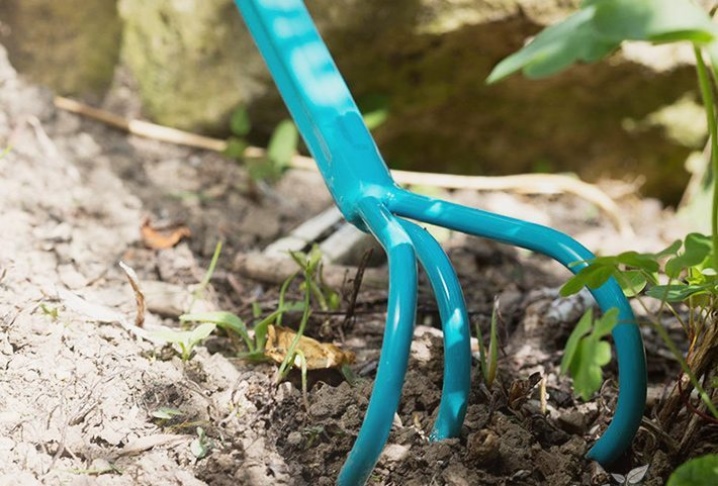
Pruning
In order for the flowering period of the culture to last, and Astrantia did not have the opportunity to grow with the help of self-seeding, the florist needs to cut off the wilted inflorescences. If you want to see the re-blooming of the starlet in one season, it is worth cutting off all the existing flower stalks.
Transfer
The procedure for transplanting Astrantia in the fall is not burdensome for gardeners, since the plant can grow and develop well in the same area for about 10 years. However, according to the recommendations of experts, star it is better to replant every 6 years.
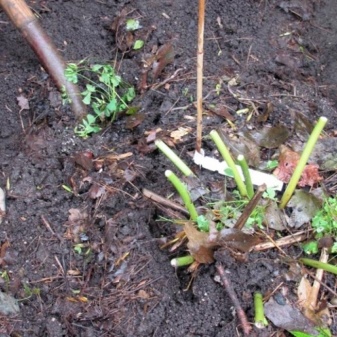
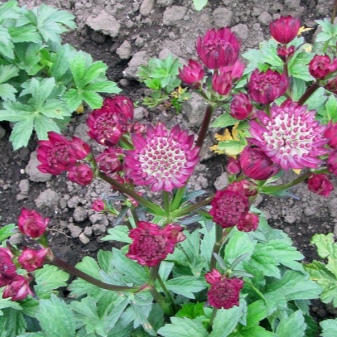
Preparing for winter
A cold-resistant representative of the flora can winter without additional shelter in central Russia.At the end of the autumn period, the bushes should be cut off, leaving only hemp on the surface of the earth. To preserve the star, it is recommended to sprinkle the crop with peat or humus. Young Astranians can suffer from low temperatures. For this reason after pruning, such plants should be mulched or covered with branches of conifers.

Reproduction methods
Astrantia reproduces not only by seeds. Many gardeners use the method of bush division in order to propagate the crop. This procedure contributes to the preservation of all varietal characteristics. It is possible to deal with the division of the star bush both in spring and in autumn, at the beginning or at the end of the growing season.
The culture must be dug up, and its roots must be divided into several parts. After this, the delenki should be planted separately. After a certain period, the seedlings will become full-fledged flowers. Since astrantia is a perennial, it is possible to wait for its flowering only in the third year of life.
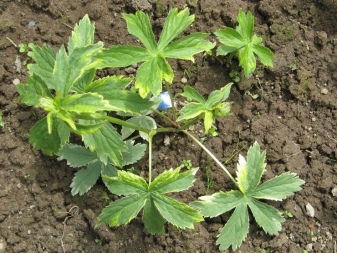
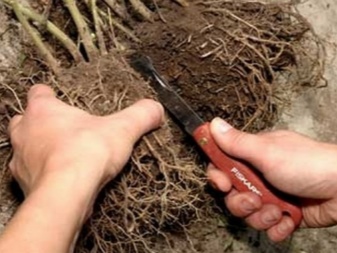
Diseases and pests
Astrantia is characterized by strong immunity and resistance to disease. Unlike other garden inhabitants, this representative of the flora rarely suffers from pest attacks. Since in natural conditions, a perennial grows in the open sun or in the shade, it is not afraid of drought, frost, lack of light.
An ailment that can destroy the starfish is a fungal infection that forms from waterlogging of the soil. Most fungal diseases can be easily eliminated with fungicides.
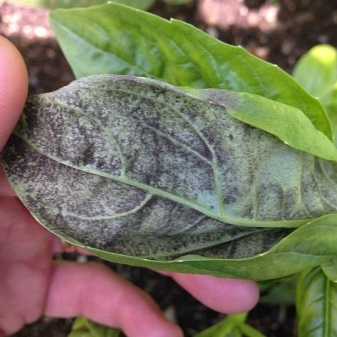

Use in landscape design
Astrantia is a perennial herb with umbrellas of pink, lilac or white, so it will look harmonious in the area next to astilba, bells and begonias.
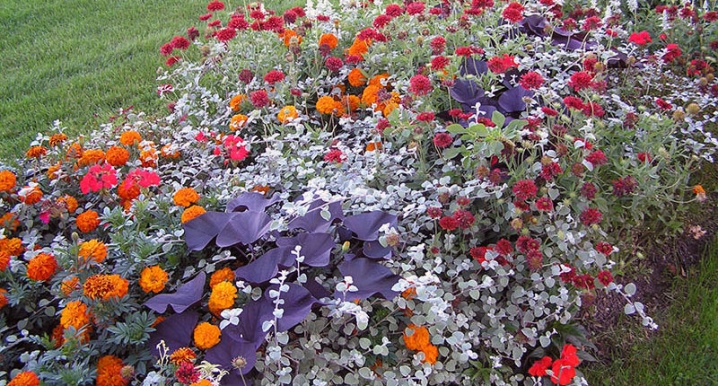
It is not recommended to plant a starlet near crops with cold petal shades.

And also astrania Is an excellent partner for planting along densely planted conifers, shrubs, hedges.

The multi-layer starry is the characteristic thanks to which it is used by landscape designers when designing a mixborder.
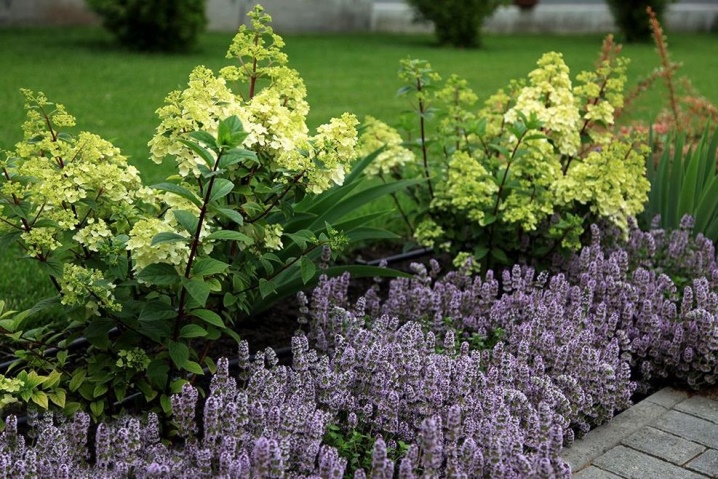
A lush curtain of this representative of the flora looks quite picturesque on an alpine hill.
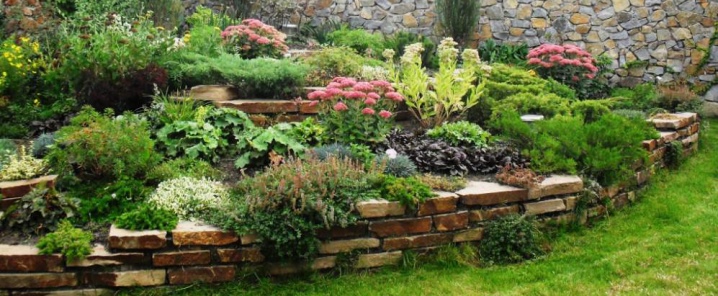
Astrantia looks great in the symmetrical pattern of a classic flower bed.

For an overview of astrania, see the video.







































































































The comment was sent successfully.